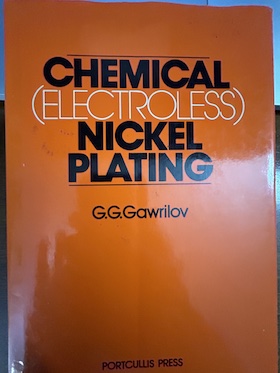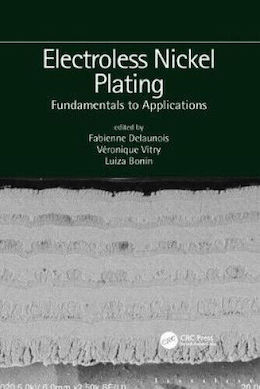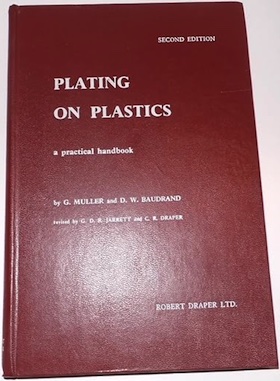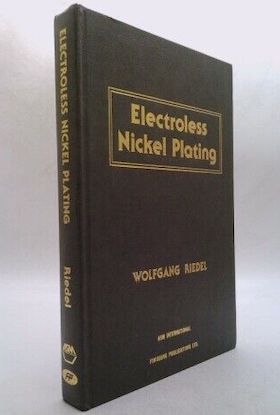
-----
Electroless Nickel: need intro and technical info
Q. Hi I am a student
I have a project on electroless coating. I chose electroless nickel but I don't find hypophosphite sodium in our country. Please help me with what I should do !!
Is there any substitute or must I change to electroless copper!
Thank you a lot.
Student - Algeria
January 29, 2023
A. Hi Billel. Other potential reducing agents are sodium borohydride or dimethylamine borane. These don't produce nickel phosphorous deposits of course.
Maybe a local or university library can get you a good book on electroless nickel plating ⇨
If not, the paper that Ken Vlach suggests below is a start :-)
Luck & Regards,

Ted Mooney, P.E. RET
Striving to live Aloha
finishing.com - Pine Beach, New Jersey
Ted can be retained for immediate
answers or long term project help
⇩ Related postings, oldest first ⇩
by G. G. Gawrilov

on eBay or Amazon
or AbeBooks
(affil link)
Q. I'm looking for technical information about Electroless Nickel, could you help me?
Ismael Colmenares Marroquinengineer - Puebla, Mexico
2004
A. Hello Ismael,
In one sentence, electroless nickel is an autocatalytic process that deposits a nickel alloy, usually nickel-phosphorous, in a smooth even layer that is hard, corrosion-resistant, and conductive.
Our list of books includes two books about electroless nickel as well as entries like the
Metal Finishing Guidebook, which has an introductory chapter.
"Products Finishing" magazine ran an annual electroless nickel conference for years, from which proceedings are available, and which cover the subject is tremendous detail.
Good luck!

Ted Mooney, P.E.
Striving to live Aloha
finishing.com - Pine Beach, New Jersey
Ted can be retained for immediate
answers or long term project help
A. Macdermid has several pages of technical information on EN coatings. To access: Home page -> Industrial Products -> Products -> Electroless Nickel -> Properties. Engineering, Mechanical and Physical Properties are given.
Heatbath has descriptions of their Nitec® low, medium and high-phosphorus ENs.
Surface Technology, Inc. gives deposit properties of each of their EN products.
The Nickel Development Institute (www.nidi.com) has an informative publication "Properties and Applications of Electroless Nickel" at http://www.nidi.org/multimedia/technical_support/technical_literature_pdfs/10000_technical_series/10081.PDF
- Goleta, California
Rest in peace, Ken. Thank you for your hard work which the finishing world, and we at finishing.com, continue to benefit from.
Ed. note: Those companies and trade groups still exist, but the directions to specific literature no longer work. The Nickel Institute is now at www.nickelinstitute.org, and the referenced paper can be found at https://www.nickelinstitute.org/media/1769/propertiesandapplicationsofelectrolessnickel_10081_.pdf
Q. 1. Suggest ways to get a smooth and good electroless nickel deposition on ABS component in an electroless nickel bath.
2. Is air agitation required in an electroless nickel bath?
Rajan Hora- Delhi, India
2002
A. Dear SIR,
To keep your electroless nickel in good working conditions I suggest the next.
1-avoid over heating
2-adjust pH at 9 with AMM sol.
3-continuous filtration
4-avoid excess reducing agent[hypo phosphite]
5-at the end the working day reduce the PH again to 7 with H2SO4
Make sure that you make double rinsing before E.N bath about your question yes air agitation is very important with best wishes of very stable bath.
RAAFAT ALBENDARY- Cairo, Egypt
A. Hi Rajan,
The answer to your second question is yes, air agitation is required.
The answer to your second question is "only with a robust cleaning, etching, and plating-on-plastics pretreatment process followed by proper electroless nickel process as described by Raafat. But the whole plating on plastic process is a bit difficult to detail in a few paragraphs. I think you'll need to get access to some some books unless you can provide some detail about the steps you are doing.

Ted Mooney, P.E.
Striving to live Aloha
finishing.com - Pine Beach, New Jersey
Ted can be retained for immediate
answers or long term project help
![]() Dear Mr Raafat Albendary,
Dear Mr Raafat Albendary,
Thanks for your prompt reply. I have applied your suggestions and have found them to be extremely useful. Thanks once again.
Regards,
Rajan Hora- Delhi, India
|
|
Q. Dear Mr. Raafat/ Mr Mooney, Thanks for the reply to my earlier query. Your suggestions were extremely useful. My question : What precautions we are supposed to take to get a smooth and good finish in Electroless copper solution? Regards, Rajan Hora [returning]- Delhi, India A. Hi again, Rajan. Sorry to inconvenience you, but the site is intended for reference as well as interactive help; and for each poster hundreds of readers are looking for reference material. Therefore we don't want threads about introduction to electroless nickel to drift into discussions about ideal operational parameters and troubleshooting of electroless copper processes.  Ted Mooney, P.E. RET Striving to live Aloha finishing.com - Pine Beach, New Jersey Ted can be retained for immediate answers or long term project help |
by Fabienne Delaunois et al

on eBay or Amazon
or AbeBooks
(affil link)
Q. Hi All,
I'm doing my M.S project on Electroless Nickel on Mild steel.
I've selected the following bath composition:
Nickel Sulphate : 40 g/l
Hypophosphite: 24 g/l
Sodium acetate: 17 g/l
acetic acid
⇦ on
eBay
or
Amazon [affil link] : 10 cc/l
lead acetate : 1 ppm
pH: 4.6-4.7
Temp.: 85 °C
with air agitation.
But I got no layer on mild steel substrate.
Can anyone help me what is the problem? Is there any problem with my bath composition? can anyone suggest better composition percentage with above mentioned chemicals?
Also please advise what is the best pretreatment process (including activation)
I have done this pretreatment process:
1- immersion in 20% sodium carbonate
⇦ on
eBay or
Amazon]
20-30 min
2- rinsing with distilled water
3- cleaning in dilute acid with 5V as cathode or anode
4- rinsing with distilled water
5- immersion in 30% HCl + 10% H2SO4 60-120 Sec
6- cleaning in dilute acid with 5V as cathode or anode
7- rinsing with distilled water
What have I done wrong ?
Many thanks in advance for your help.
Sharif University of Technology - Tehran, Iran
2007
A. Slowly increase your pH to 5.2-5.4 (w/ammonium hydroxide) and temperature to 90 °C. It should work. If it doesn't, prepare a new bath without lead acetate, which may be added after the bath has started. If it still doesn't work, maybe they gave you the wrong chemicals or they are contaminated. For academic purposes, it may be O.K. but remember this is an old recipe to make-up a new bath. It doesn't tell you what you should replenish and when. Your bath will be very unstable and have a very low turnover life. It will also co-deposit some lead which is a very toxic and regulated metal. Modern and successful plating plants use proprietary formulations that overcome these problems.
Guillermo MarrufoMonterrey, NL, Mexico
Q, A, or Comment on THIS thread -or- Start a NEW Thread



